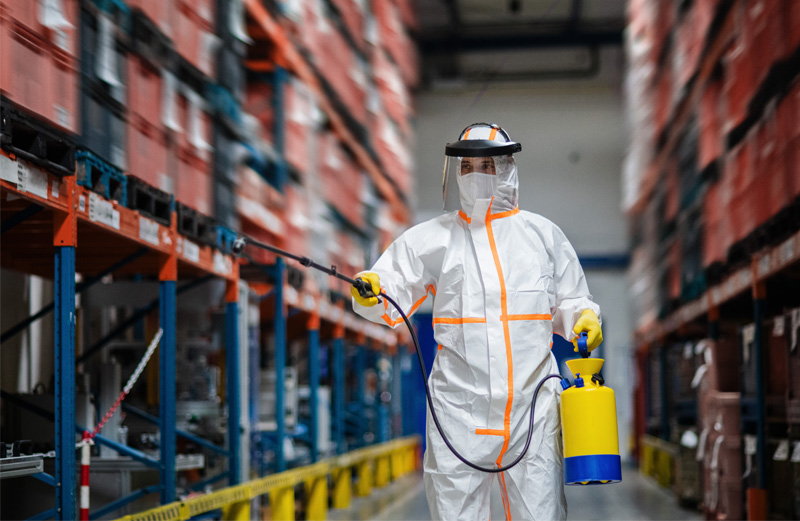The COVID-19 pandemic has been a learning experience for organizations to refocus priorities, innovate to survive, and to be part of the global solution to stop the transmission of the disease.
From the onset of the pandemic in spring, organizations, like the general public, have applied the prevention measures mandated by the Public Health Authorities; by now, eight months after public health authorities have started to actively give guidance on how to stop the spread of the coronavirus, we all know what to do, as summarized simply by the Centres for Disease Control and Prevention : understand how the virus spreads, avoid close contact, cover your mouth and nose with a mask, wash your hands often, cover coughs and sneezes, clean and disinfect, and monitor your health daily.
Yet, the current wave of COVID cases, which has yet to peak, brings back the harsh reality that not only do these measures need to be scrupulously maintained, but they also need to be improved.
Some jurisdictions have currently attributed a large proportion of transmission cases to the workplace. This fact caused us at Cognibox to ask ourselves how we can help organizations improve their COVID prevention measures. We hope that our reflection on using technology to implement a management-system-based approach to COVID-19 will give you a different light to assess areas of opportunity of your current COVID prevention program.
What is different with a management-system approach to stop the transmission of COVID-19 in workplaces?
At the start of the pandemic, Public Health Authorities published the simple guidelines mentioned above, and it took some time until occupational health & safety (OHS) professionals started to articulate them into the well-known Hierarchy of Controls.
This is why, at the start of the pandemic, most of the talk/action/problem was about PPEs (masks, gloves), and focusing on changing the behaviours of people in terms of respiratory etiquette and hand hygiene.
Once OHS professionals took over to control the risk of transmission in their workplaces, they articulated the measures to take based on the hierarchy of controls, knowing that better than trying to find masks and gloves to equip the workers, there are physical changes to make to the workplace to halt the propagation of the virus. We then saw plexiglass dividers and curbside pick-up popping-up in businesses, as these were engineering controls, which as the hierarchy of controls tells us, are much more effective then PPEs.
Our webinar explains in more detail the hierarchy of controls, which is an improved way to structure the control measures to put in place, but yet, is not the be-all-end-all.
Indeed, although eight months later we can see that workplaces have focused more of their efforts on eliminating the risk of transmission at the source (maintaining remote work, forbidding site access to people self-diagnosing/exhibiting COVID symptoms) and on physically reconfiguring their workplaces (engineering controls), the reliance on administrative and PPEs is still significant; those last two types must remain as we cannot forego employee hygiene practices and sound decisions, as a workday is impossible to confine to a plexiglass stall.
So what has been missing?
If the pandemic had been curbed in a couple of months by immunity through a vaccine & natural immunity, we would have been okay with our initial implementation of the recommended public health measures.
However, here we are eight months later, with lackluster results. It is time to look at other approaches; one approach that works well for this is the proven “Plan-Do-Check-Act” model, because what needs to happen now is to “Check” if those measures implemented in the spring have been maintained on the floor, and if they have produced the expected results. If not, we need to provide accurate information to our leaders on what and how to “Act” to fix and improve our COVID prevention measures.
One should not assume without verification that jobs with the most interactions had been or continue to be properly protected with engineering controls instead of administrative controls and PPEs, that employees have maintained distancing from their colleagues and properly wear their masks, or that disinfectant dispensers are always replenished.
There is nothing more normal in human endeavours than wear and tear, fatigue about new norms, reverting to old habits and not getting something perfect the first time around. Due to this, “ACTING” to correct and improve based on checking on the results needs to be a formal institutionalized process, based on observation and actively getting the feedback of employees who have to implement the measures.
The processes to implement this approach are summed up in a management system model, with ISO 45001 as the relevant one to manage a biological risk such as COVID-19 transmission. ISO 45001 is not only based on the PDCA approach, it also structures the controls to take following the hierarchy of controls. The challenge that now lies ahead for organizations is to apply a management-system approach to their efforts to eliminate COVID transmission in the workplace. It is an uphill battle as verifying symptoms of everybody coming on-site is repetitive, tedious, and massive for large organizations. As well, inspecting worksites to ensure maintenance of the controls gives guidance on what to fundamentally change only when results are collated to find trends, and total control can only be achieved when organizations not only know about their preparedness and ability to execute, but also that of their suppliers that come into their facilities.
Executing the Management System Approach
The management system approach theory is sound on paper; the challenge is to implement it efficiently in real life, and the improved results cannot wait another year before materializing.
Between the daily screening of dozens of individuals, inspecting areas for compliance, getting employee feedback, and assessing supplier preparedness, the task is daunting without the use of technology.
Cognibox has packaged the technological tools that your organization requires to implement its management-system approach to COVID-19 into its CogniSafe tool.
CogniSafe will be automatically added to the member contractor’s profile in Cognibox and the daily pre-entry screening will be available in the Cognibox mobile application. This tool is available to our client corporations and contractors, as well as any other company in-need in Quebec and Ontario.
With CogniSafe:
- Client corporations and contractors can train themselves on best practices, rule implementation and preparatory measures
- Client corporations and contractors can perform a daily audit and checklist to assess work site adherence and confirm that daily hygiene rules are respected
- Client corporations and contractors can evaluate the workplace preparedness
- Contractors can instruct their workers to fill out a daily pre-entry screening questionnaire and they will be able to prohibit them from entering the site if the screening shows a potential risk
All in all, a better management system approach will help you create sustainable effectiveness by developing a comprehensive control of hazards. As we experience a second wave, it is more important than ever for you to use an occupational health and safety management system to reduce the spread of COVID-19, and using technology will help you save time in implementing the objectives and processes in your organization.





